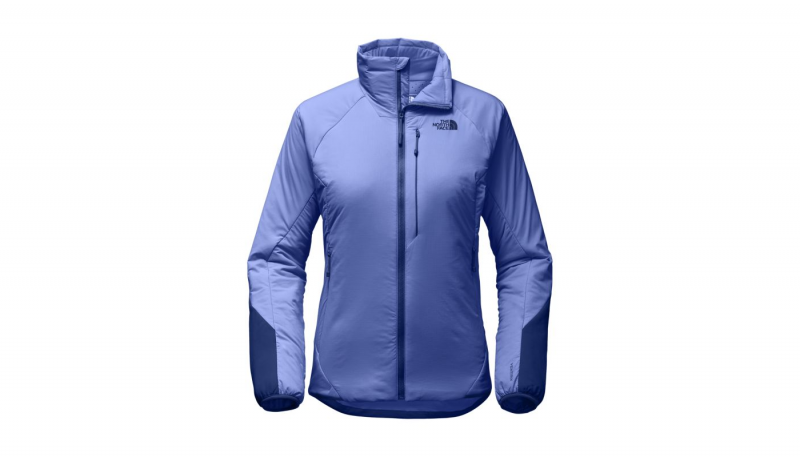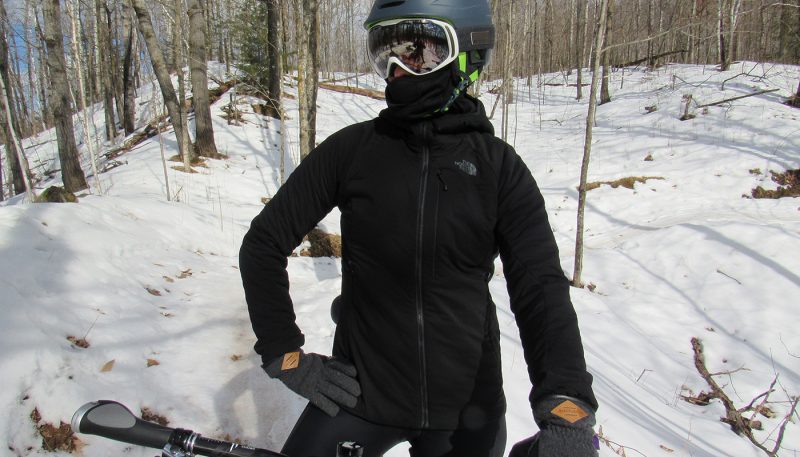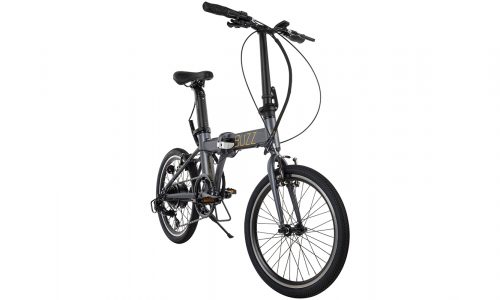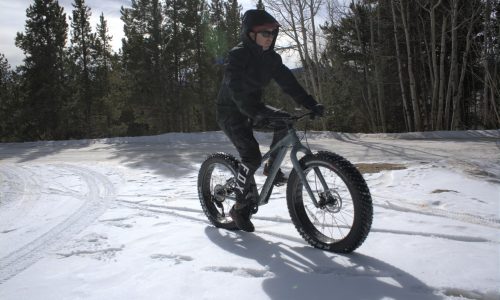Home » Gear Reviews » Biking » The North Face Ventrix
The North Face Ventrix Review
March 16, 2018



















 79
79 The Good
- Fit allows for a variety of baselayers
- Durability
- Breathability
- Soft and comfortable
The Bad
- Minimal features
- Non-helmet compatible hood
- Hood has no adjustments
Weather-resistance
The North Face Ventrix is constructed with a DWR-treated softshell exterior that provided good water-resistance in moderate snow only. When we rode at a higher exertion rate in heavier snowfall, we noticed that the snow on the jacket melted due to the excessive heat being generated, causing ice to build up on the arms and shoulders. Although not waterproof, testers still remained dry due to the colder temperatures not allowing the ice build up to melt through.
For wind-resistance, we found that the Ventrix provided the best degree wind-resistance in gusts up to fifteen miles per hour. In gusts above that, we definitely felt the wind penetrating.
Even though the Ventrix is not a cycling-specific jacket, its longer tail provided the same amount of extended coverage in the back as the cycling-specific jackets. Its longer front did not feel bunchy in the waist when in the more aggressive riding positions because of the softer fabric.
Breathability
Breathability is good in The North Face Ventrix. The Ventrix fabric contains miniscule laser-cut holes under the arms along the exterior and along the inside of the back of the neck that work as “micro vents.” The holes are designed to stay closed when inactive to retain heat and then open to allow airflow as the cyclist moves and stretches the fabric. The more the cyclist moves and stretches the fabric, the wider the holes open, increasing airflow as needed for the level of exertion. Although we never actually witnessed the micro vents opening and closing, testers felt the most comfortable in the Ventrix on a twenty-two mile fatbike ride in temperatures as low as zero degrees with minimal wind and wearing a hydration pack.
Warmth
The North Face Ventrix is insulated with 80 grams of Ventrix stretch synthetic insulation making it comfortable for cycling in temperatures as low as zero degrees with moderate wind. Contributing to its warmth is the Ventrix fabric’s laser-cut perforations. These “mirco vents” are designed to expand and release heat or contract and retain heat based on the intensity of the cyclist’s movement. When taking a break on the trail, the perforations close to provide greater insulation. When riding or moving, the perforations open wider to transfer heat and perspiration. Although the scuba hood is not helmet friendly, when the jacket is fully zipped, the hood collar feels extra snuggly.
Its slim fit allowed us to wear a heavy-weight merino wool base layer or a lightweight baselayer and a mid-layer vest to keep her comfortable on rides in temperatures from zero to twenty-five degrees.
Unlike the semi-fitted cycling-specific jackets, the stretchy fabric in arms easily accommodated a heavy-weight long-sleeve baselayer without feeling tight or constricted or bunching up. With an excellent insulation-to-weight ratio, it is not a bulky jacket. Hydration pack waist straps needed to be loosened only slightly.
Durability
The North Face Ventix is the second most durable jacket in the test. Its forearm panels are reinforced with 50D x 40D nylon to prevent rips when brushing up against rocks, branches or making contact with bare trail. The rest of the jacket is constructed with a 30D x 20D shell. Stitching is straight and tight and the zippers and zipper pulls glide easily without getting caught in the fabric.
Features
Though not officially designed for cycling, the North Face Ventix has some unintended features that make it cycling-friendly. Its longer rear hem over the backside gives it a bit of a drop-tail design to repel sleet and snow that gets kicked up from the rear tire. Its longer sleeves and stretchy fabric do an excellent job of providing coverage in all cycling positions. Its slim fit allows for layering without bulk.
A very roomy zippered chest pocket easily holds a smartphone, GPS or maps. Two zippered hand pockets are also oversized and are excellent for carrying snacks or tools. The zipper pulls are glove friendly, even when wearing heavy insulated winter gloves.
The Ventrix is available with or without a hood, however the hood is not helmet friendly and has no adjustments on the back or sides.
All cycling jackets were tested on six-plus mile commutes to work each way on designated urban bike paths and bike lanes, as well as fatbike rides up to eighteen miles. The test period ran from early January to mid-February in temperatures that ranged twenty degrees below zero with wind chills to twenty-five degrees above zero with gusty wind, as well as rides in falling snow.
Marie Malinowski is a Minneapolis-based mountain biker, bike commuter, backpacker, and trail runner who covers our cycling accessories categories.



















